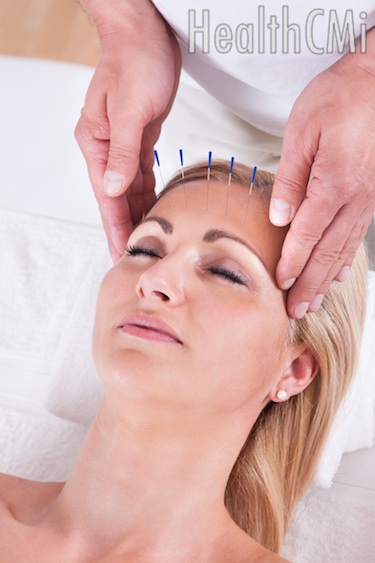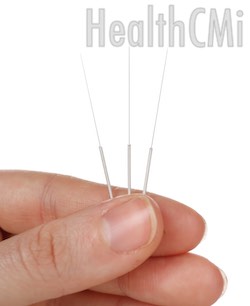Acupuncture provides significant relief for migraine sufferers. Researchers conducted a randomized-controlled trial of 87 patients comparing the effectiveness of two acupuncture point prescriptions. Both protocols were effective, however, one approach delivered significantly superior patient outcomes. 
Two groups were compared. Patients in group 1 received acupuncture at Siguan and gallbladder meridian acupuncture points. Siguan, roughly translated as the four gates, is a combination of acupuncture points Hegu (LI4) and Taichong (LR3). Gallbladder meridian points used in group 1 included:
Fengchi (GB20)
Shuaigu (GB8)
Qiuxu (GB40)
Zulinqi (GB41)
Group 2 did not receive acupuncture needling at Siguan but received acupuncture at acupuncture points:
Fengchi (GB20)
Shuaigu (GB8)
Qiuxu (GB40)
Zulinqi (GB41)
Yanglingquan (GB34)
Hanyan (GB4)
Treatments were applied three times per week for six weeks in both groups. Migraine frequency, intensity and duration were compared after completion of the six week regime of care and in a three month follow-up investigation.
After the six weeks of patient care, group 1 exhibited a total effective rate of 95.2% and group 2 exhibited an 80.0% total effective rate. The three month follow-up documents an 88.1% total effective rate for group 1 and a 75.6% total effective rate for group 2. Based on these findings, the researchers conclude that Siguan combined with gallbladder meridian acupuncture points is more effective than the acupuncture point prescription used in group 2 wherein only gallbladder meridian points were used.
Jie Yang et al. note that acupuncture “induce(s) different cerebral glucose metabolism changes in pain-related brain regions and reduce(s) intensity of pain” for patients with migraines. In a randomized-controlled study using PET-CT neuroimaging, acupuncture was shown to be effective for migraine pain reduction. The imaging revealed that acupuncture raised glycometabolism in the middle temporal cortex, orbital front cortex, middle frontal gyrus, angular gyrus, post cingulate cortex, the precuneus and the middle cingulate cortex. Acupuncture simultaneously lowered glycometabolism in the parahippocampus, hippocampus, fusiform, postcentral gyrus, and the cerebellum in migraine patients. The study also showed that acupuncture point choices determined changes in brain glycometabolism. The researchers note that this measurable phenomenon indicates acupuncture point specificity.
Subjects with migraines were separated into three groups: Traditional Acupuncture Group (TAG), Controlled Acupuncture Group (CAG), non-intervention group. The non-intervention group did not receive treatment. The TAG group received acupuncture stimulation at acupuncture points:
- TB5 (Waiguan)
- GB34 (Yanglingquan)
- GB20 (Fengchi)
The CAG group received acupuncture needling at acupuncture points:
- ST8 (Touwei)
- LI6 (Pianli)
- ST36 (Zusanli)
The TAG group showed the most significant reductions in migraine related pain. Additionally, the glycometabolism was higher in the TAG group than in the non-intervention group in the:
- Middle temporal cortex
- Orbital frontal cortex
- Middle frontal gyrus
- Angular gyrus
- Post cingulate cortex
- Precuneus
- Middle cingulate cortex
The TAG group decreased glycometabolism over the non-intervention group in the:
- Parahippocampus
- Hippocampus
- Fusiform
- Postcentral gyrus
- Cerebellum
The CAG group more greatly increased glycometabolism over the non-intervention group in the:
- Middle temporal cortex
- Supratemporal gyrus
- Supramarginal gyrus
- Middle cingulate cortex
The CAG group decreased glycometabolism more greatly than the non-intervention group in the cerebellum.
Vijayalakshmi et al. find electroacupuncture more effective than “conventional drug therapy” for the treatment of migraines. Electroacupuncture significantly outperformed the drug flunarizine in the treatment of migraines. Acupuncture patients demonstrated superior patient outcomes for several measures: pain relief, psychological profile improvements, overall quality of life, disability reduction. The researchers conclude that acupuncture is an effective alternative or adjunct method of care for migraine patients.
Ling Zhao et al. concur that acupuncture is effective in reducing pain intensity levels for migraine sufferers. Zhou et al., performed an investigation finding acupuncture effective in the prevention of migraines. The research links acupuncture’s therapeutic benefits to its ability to stimulate MLCK (myosin light-chain kinase) expression. The expression of MLCK is involved in the regulation of smooth muscle contraction. The researchers document a correlation between acute migraine attacks and decreases of MLCK via the CGRP (calcitonin gene-related peptide) signal system. The researchers discovered that applying acupuncture to acupuncture point GB20 (Fengchi) successfully upregulates MLCK expression and has “preventative and curative” effects for migraine sufferers.

Dr. Cayir et al. conclude that there is a “clinically relevant decrease in MMP-2 activity in patients with migraine treated with acupuncture. The mechanism underlying the effect of acupuncture in alleviating pain may be associated with a decrease in MMP-2 activity.” Matrix metalloproteinase-2 (MMP-2) is an enzyme involved in vascularization, tissue remodeling, and inflammatory responses.
In the experiment by Dr. Cayir et al., migraine patients received a total of “10 sessions of acupuncture treatment. The points selected were bilateral ST8, ST44, LI4, LI11, LIV3, SP6, GB1, GB14, GB20, GV14, GV20, Yintang, Taiyang and ear Shenmen.” Blood samples were taken before and after treatment to determine MMP-2 concentration and activity levels. Acupuncture significantly alleviated the migraine pain intensity. Notably, MMP-2 concentrations remained relatively stable but MMP-2 activity significantly decreased.
Rosenberg et al. confirm that acupuncture downregulates expression of proinflammatory enzyme MMP-2. Application of acupuncture in a laboratory test of cerebral artery occlusion causing cerebral ischemia/reperfusion demonstrates that acupuncture increases neurologic function including motor, balance and sensory improvements. Infarct size was also significantly reduced by the application of acupuncture. The research team discovered that application of acupuncture points GV20 and ST36 reduced infiltration of inflammatory cells, downregulated expression of proinflammatory enzyme MMP-2, reduced expression of water channel proteins AQP4 and AQP9, reduced brain ischemia and decreased brain edema due to inflammation.
Guo et al. conclude that acupuncture is more effective than flunarizine hydrochloride for controlling migraines. Researchers compared a Traditional Chinese Medicine (TCM) combination of acupuncture and tuina massage with the oral medication flunarizine hydrochloride. The TCM treatment was significantly more effective than the drug treatment for reducing pain frequency, intensity and duration due to migraines. The acupuncture combined with tuina group had a total effective rate of 93.8% whereas the medication group only achieved a 63% total effective rate.
Additionally, the acupuncture with tuina group had significantly fewer relapses. As a result of the findings the researchers conclude, “Combining electroacupuncture and local tuina can obtain better effect and lower relapse rate than oral flunarizine Hhdrochloride capsules in migraine patients.”
The acupuncture group received electroacupuncture at ashi points, Taiyang, ST8 (Touwei), GB13 (Benshen), Xuanlu (GB5) and GB41 (Zulinqi) on the side with focal pain. GB20 (Fengchi), GV20 (Baihui) and GV24 (Shenting) were also needled. The treatment principles were to dredge the channels, remove pathogenic factors and stop pain. Secondary acupuncture points were added for specific disorders:
Liver yang rising headaches: LR3 (Taichong), KI3 (Taixi), GB43 (Xiaxi)
Phlegm turbidity headaches: CV12 (Fenglong), SP9 (Yinlingquan)
Blood stasis headaches: PC6 (Neiguan), SP10 (Xuehai), BL17 (Geshu)
The acupuncture treatments were applied in the seated patient position. Needles were 0.30 mm x 25 - 50 mm. De qi sensation was evoked at the acupoints followed by one minute of the sedating technique by either twirling or rotating. Electroacupuncture involved a sparse-dense wave and the frequency ranged between 2 - 100 Hz. Total needle retention time was 20 minutes and the acupuncture was applied one time per day. One course of treatment consisted of 10 days. Two courses of treatment were applied with a 3 day break between courses of care.
Tuina massage was applied with several techniques. Regions receiving tuina massage were:
- Yintang
- Taiyang
- GV20
- GB20
- ST8
- TB20 (Jiaosun)
- BL2 (Cuanzhu)
Overall, the head received tuina massage at the forehead and lateral sides of the head at the gallbladder foot-shaoyang channel area. Acupuncture combined with tuina massage consistently outperformed the medication group. As a result of the findings, the researchers conclude that acupuncture combined with tuina massage is effective for the treatment of migraines and is more effective than administration of flunarizine hydrochloride.
References:
Lin, X. M., X. Yao, and Z. Di. "[Acupuncture at" Siguan" combined with Gallbladder Meridian acupoints for migraine: a randomized controlled trial]." Zhongguo zhen jiu= Chinese acupuncture & moxibustion 34, no. 10 (2014): 947-950.
Rosenberg GA, Yang Y (2007) Vasogenic edema due to tight junction disruption by matrix metalloproteinases in cerebral ischemia. Neurosurgical focus 22: E4. doi: 10.3171/foc.2007.22.5.5
Vijayalakshmi, I., N. Shankar, A. Saxena, and M. S. Bhatia. "Comparison of effectiveness of acupuncture therapy and conventional drug therapy on psychological profile of migraine patients." Indian journal of physiology and pharmacology 58, no. 1 (2013): 69-76.
Goldman, Nanna, Michael Chen, Takumi Fujita, Qiwu Xu, Weiguo Peng, Wei Liu, Tina K. Jensen et al. "Adenosine A1 receptors mediate local anti-nociceptive effects of acupuncture." Nature neuroscience 13, no. 7 (2010): 883-888. Affiliations:
Center for Translational Neuromedicine, University of Rochester Medical Center, Rochester, New York, USA.
Department of Neurology, Boston University School of Medicine, Boston, Massachusetts, USA.
National Institute of Diabetes and Digestive and Kidney Diseases, US National Institutes of Health, Bethesda, Maryland, USA.
Zhao, Ling, Ji-xin Liu, Ying Li, Wei Qin, Fan-rong Liang. "Effects Of Long-term Acupuncture Treatment On Resting-state Brain Activity In Migraine Patients: A Comparative Study On Active Acupoints And Inactive Acupoints." Journal Of Integrative Medicine 3 (2014): 234.
ZHOU Pei-juan, LI Bai, WANG Ai-cheng, LIU Chun-yan, WANG Yu, [Effect of Fengchi Point on the Expression of Myosin Light Chain Kinase on Middle Meningeal Artery of Migraine Model rats,] Acta Chinese Medicine and Pharmacology, 2014,(5), R285.5.
Cayir, Yasemin, Gokhan Ozdemir, Mine Celik, Hulya Aksoy, Zekeriya Akturk, Esra Laloglu, and Fatih Akcay. "Acupuncture decreases matrix metalloproteinase-2 activity in patients with migraine." Acupuncture in Medicine 32, no. 5 (2014): 376-380.
A PET-CT study on specificity of acupoints through acupuncture treatment on migraine patients. Jie Yang, Fang Zeng, Yue Feng, Li Fang, Wei Qin, Xuguang Liu, Wenzhong Song, Hongjun Xie, Ji Chen, Fanrong Liang.
Guo, Qing, Yu Hua, Hai-qin Wang, Ying Li, and Quan Ji. "Therapeutic effect observation on combining electroacupuncture and tuina for migraine." Journal of Acupuncture and Tuina Science 12, no. 3 (2014): 174-179.


